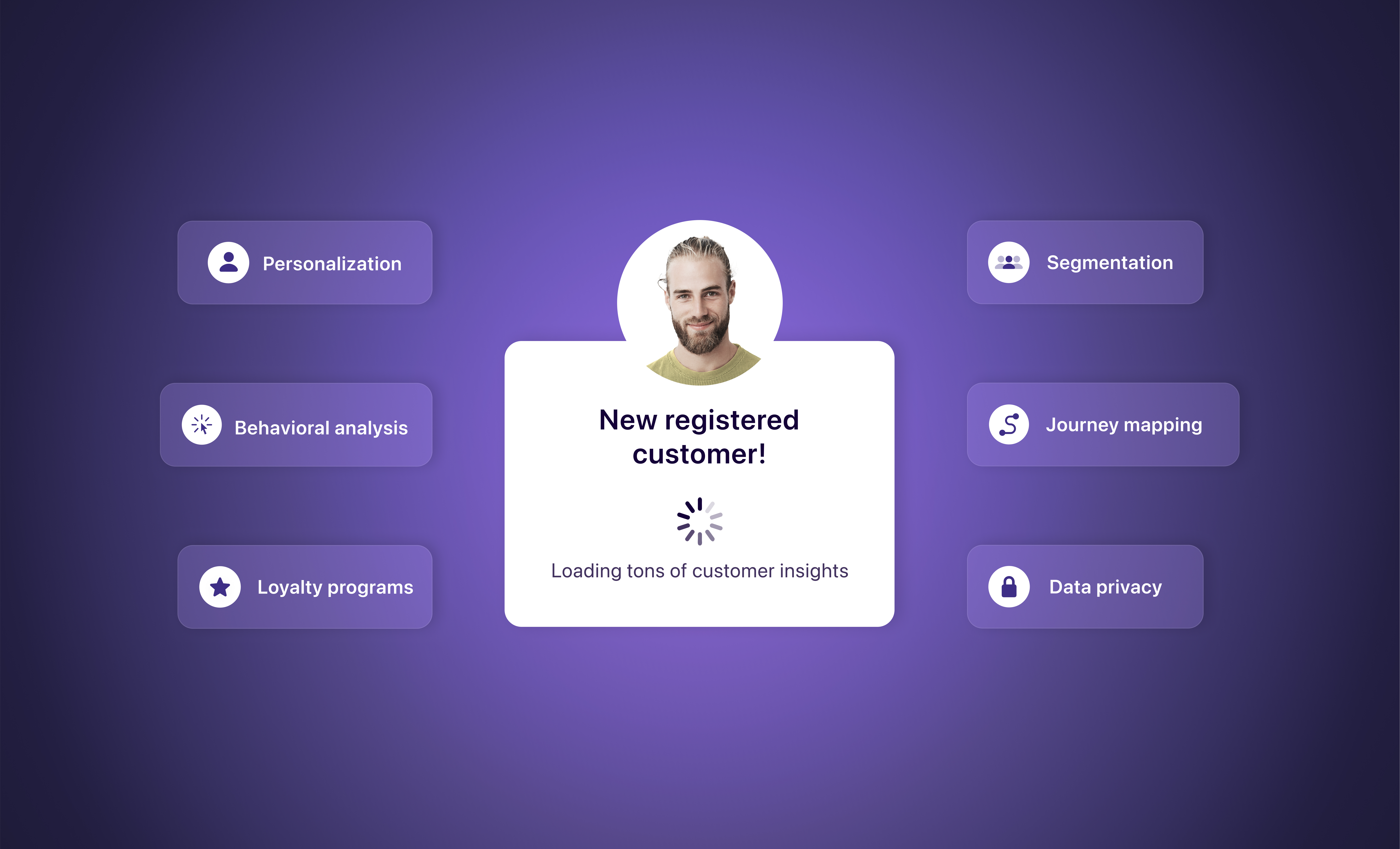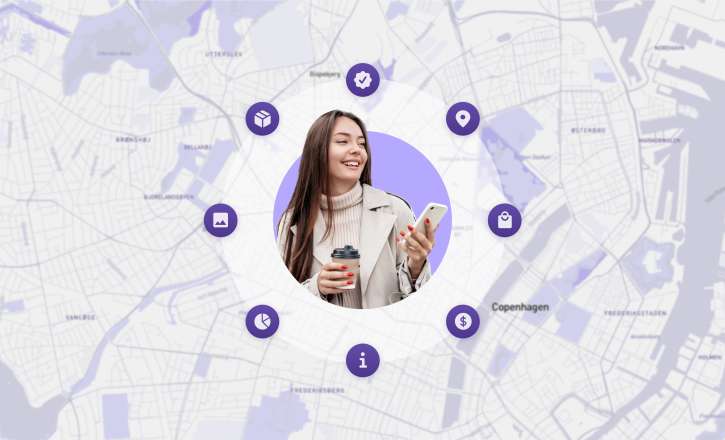
In today's competitive business landscape, you need as much data as possible. But decentralized data spread over various platforms is practically useless. The focus on personalized customer experiences is increasing by the second. Without a way to centralize data and generate insights, businesses fall behind their competition.
This has led to the rise of a vital technology called the Customer Data Platform (CDP). It unifies your customer data from various sources. As a result, you get a cohesive profile for audience segmentation and personalized experiences.
Unlike Data Management Platforms (DMP) and CRMs, CDPs enhance data utilization and consent and simplify data organization. The importance of CDPs in the current market is undeniable. They offer insights into customer behavior, driving decisions, optimizing marketing across channels, and enabling omnichannel campaigns — all things businesses desperately need.
The market size of CDPs was about $3.49 billion in 2021. Its size is expected to increase to $49.80 billion in this decade. The surge in CDP adoption reflects the broader business focus on real-time personalization and data-driven interactions.
In this article, we will delve into the integral aspects of CDPs, focusing on eight prominent use cases of this software. You will learn why consumer goods companies use CDPs, case studies of successful companies, and how Layerise can help.
What is a Customer Data Platform?
A Customer Data Platform (CDP) is a software system that gathers, unifies, and centralizes customer information from different sources. Such platforms merge data into a single customer database. The goal is to enable personalized and enhanced customer experiences. CDPs operate by collecting first-party data directly and enhancing it with third-party data. These platforms then aggregate, transform, and activate data for targeted marketing and customer-centricity.
Most CDPs have cloud-based infrastructures for data unification. That ensures centralized control and real-time processing for your teams. CDPs also use technologies like AI and NoSQL databases to ingest and display data. Using these, you can enjoy quick and accurate insights for marketing, sales, product improvement, and loyalty enhancement.
How do CDPs differ from CRM and DMP?
CDPs stand apart from Customer Relationship Management (CRM) systems and Data Management Platforms (DMPs) in significant ways:
CRMs manage customer interactions but lack the behavioral data (customer engagement with your brand on social media, websites, and in-store) collection that CDPs provide.
DMPs use third-party data for anonymous profiles, while CDPs focus on known customers and offer personalized experiences.
CDPs excel in managing first-party data and ensuring compliance with privacy laws. In contrast, DMPs and CRMs have limited functionality in these areas.
Various CDPs are commercially available with functionalities tailored to meet specific industry needs. Top names include Layersie, Amperity, BlueConic, and Salesforce.
In a nutshell, CDPs represent a transformative technology that centralizes and leverages customer data for personalized marketing and improved engagement. By distinguishing themselves from CRM and DMP systems, CDPs offer unique solutions that enable businesses to adapt to modern marketing needs and privacy requirements.
Why do companies use CDPs?
Only learning about what a platform does is not enough to use it effectively. You should look at how others use the system and build on that for your business. So let us look at the three most common ways companies use CDPs. These will show you how CDPs can be vital for your organization to maintain an edge in a competitive landscape. But first, some practical examples:
Food and beverage industry: Starbucks uses a CDP to enhance its loyalty program. They analyze purchase patterns, preferences, and locations to send personalized offers and rewards to customers through their mobile app.
Healthcare sector: Leveraging a CDP, Cambia Health Solutions unified data across their family of brands to improve customer view and personalize the customer experience at every interaction.
Travel and tourism: Delta Air uses customer data to tailor travel experiences. They provide personalized flight updates, airport directions, and even dietary preferences based on previous travel behavior.
Enhanced personalization
As you have read above, CDPs create unified customer profiles by consolidating customer data from diverse sources. Data includes demographics, purchase history, and social media interactions, to name a few. But how can these profiles benefit your business? By improving your understanding of the customer and their needs. Such consolidated data offers opportunities for unmatched personalized engagement. Here are a few more benefits:
Tailored experiences: Using the unified customer profiles, you can tailor digital experiences, enhancing overall engagement.
Improving ROI: Through personalization and automation, you can enhance ROI, optimize processes, and boost cross-channel measurement.
AI integration: AI enables targeted experiences, adds value to personalization, and fosters targeted strategies.
Product delivery: CDPs inform product development by offering personalized marketing and valuable customer insights.
Practical example: Nike's app utilizes customer data to offer personalized product suggestions based on users' activities, sports interests, and previous purchases.
Compliance and data protection
CDPs offer robust solutions to comply with critical privacy laws like GDPR and CCPA.
Centralizing repositories: CDPs assist your teams in consolidating data repositories. That allows for efficient management, protection, and auditing of customer information.
Data privacy assurance: Besides compliance, CDPs also ensure data privacy and provide real-time segmentation for targeted campaigns.
Security: CDPs, like Layerise, strongly emphasize robust security measures to adhere to regulatory requirements.
Targeted marketing
CDPs provide essential services for incredible segmentation and targeted marketing.
Customer segmentation: CDPs segment customers based on behavior, preferences, and history to enhance tailored experiences.
Strategic data use: Through strategic data use, CDPs drive revenue growth, boosting engagement, loyalty, conversion rates, and revenues.
Cross-channel marketing: CDPs integrate with other marketing tools for a seamless multi-touchpoint customer journey, facilitating consistent omnichannel experiences.
CDPs are a critical solution for contemporary marketing. They provide a competitive edge. These contribute to improving customer relationships and achieving business goals through enhanced personalization and targeted fulfillment.
We know that advancements in privacy, security, AI, and real-time analysis will continue to shape personalized and engaging customer experiences. With that in mind, CDPs are an undeniably important piece of software that every business should invest in.
Top use cases of customer data platforms
The importance of data in today's marketing cannot be overstated. Whether you want to improve your understanding of user behavior, optimize campaigns, or deliver personalized experiences, you need robust data management. Central to this objective is the Customer Data Platform (CDP). Here are some primary use cases for CDPs with a focus on marketing:
1. Personalized experiences
CDPs can drive look-alike modeling, enhancing the power of advertising platforms. Utilizing data insights, you can endorse products to specific customer segments, ensuring relevance. It offers excellent opportunities for cross-selling and upselling. For example, Sephora's Beauty Insider program uses customer data to provide personalized product recommendations, exclusive offers, and tailored beauty tips based on individual skincare and makeup preferences.
CDPs can provide predictive data insights. You can use it to refine behavior prediction and deliver finely-tuned marketing messages. You can use CDPs for targeted advertising, product endorsements, and personalized marketing messages. Leveraging user profiles, marketers can create highly customized campaigns using tools like Facebook ads, websites, and emails.
In this era where personalized experiences are vital, companies like Nike, Air BnB, and countless others use CDPs to understand audiences and personalize ads, enhancing the customer journey.
2. Data unification
Single customer view is gold for marketers. It offers detailed, actionable insights that your marketing teams can instantly use. CDPs centralize first-party customer data from various systems, offering a unified view of each customer.
They connect various platforms using connectors, SDKs, webhooks, and APIs. Hence, CDPs bridge gaps in the customer journey by linking online and offline data. Platforms like Layerise emphasize unifying fragmented data into a single database to provide precise online and offline insights.
Media brands leverage CDPs to unify data for improved insights, overcoming legacy system limitations. You can use CDPs to create single customer views, use the data to enhance your marketing outcomes and sales, and do R&D for new products. Using CDPs for data unification offers the benefit of not worrying about duplicate data or different data formats because the platform will structure it per your commands.
3. Customer segmentation
Segmentation in a CDP involves forming groups based on specific conditions such as traffic, age, buying patterns, and location. CDP gathers, segments, and activates customer data for impactful marketing campaigns across channels. For example, Layerise uses attributes like traffic, device, and location for audience creation. You can then create segmented email lists and achieve higher open and click-through rates.
You can use a CDP to segment your audience based on demographic factors (age, race), behavioral factors (frequent buyers, window shoppers), psychographic factors ( eco-conscious, tech heads), and many more types of data.
CDPs enhance behavior predictions by understanding transactional data and customer behavior, improving your marketing messages. Additionally, assessing the performance of marketing campaigns becomes straightforward with the aggregated data CDPs offer.
4. Enhanced analytics
From web and app analytics to behavioral aspects, CDPs provide a 360-degree view of the customer. CDPs gather various data types, including identity, descriptive, quantitative, and behavioral, to optimize media campaigns, retargeting, search ads, and more.
You can design impactful marketing campaigns using unified data, analytical dashboards, and audience segments. Analytics allow data-driven decision-making, leading to better ROI. CDPs also aid in automated emails, precise targeting, personalized content, and efficient resource allocation, improving ROI.
Through enhanced analytics, you can monitor the performance of campaigns in real-time. You can identify which channels, messages, and strategies yield the best results and make immediate adjustments to optimize campaign effectiveness. Real-time personalized campaigns drive engagement, conversion, and loyalty.
5. Real-time engagement
You can use the information from CDPs to trigger real-time interactions based on customer behavior. That can significantly boost customer retention. Companies with excellent omnichannel real-time engagement enjoy approximately 89% increase in customer retention. That is an excellent return for a minor change in your marketing approach.
Moreover, you can enhance brand loyalty through personalized communication. Nearly 66% of customers consider going to a different brand if their experience with the first brand is not personalized. If you do not want to lose a big chunk of your customers, use a CDP for real-time customer engagement across multiple channels.
6. CCPA, GDPR compliance
Compliance with regulations like CCPA and GDPR is essential. With tools like consent manager integration and sensitive data handling, CDPs ensure compliance with data protection regulations. Data from the UN shows that 71% of countries have data privacy laws. Therefore, you should consider using a CDP to ensure your business complies with local and international privacy policies.
7. Behavioral retargeting
CDPs allow marketers to retarget customers with relevant ads based on their previous interactions with the brand. For example, you can create an audience of users who abandoned their shopping carts without completing a purchase and retarget them with personalized ads. This increases the likelihood of conversion. Nearly 24% of customers return to websites due to retargeting.
You can retarget the customer on various platforms such as email, social media, website recommendations, and display ads.
8. Geotargeting and localized campaigns
CDPs facilitate geotargeting. You can use the data to create location-specific campaigns and offers based on customer locations. For example, Ultra Beauty used location-specific marketing to promote their new store openings. Localized targeted messaging made the store openings 2.5x more successful than other stores. It also increased customer visitations by 43%.
CDPs can aid in localized campaign design through automatic geographic segmentation and language customization. They can offer analytics for performance measurement and A/B testing to improve the ROI of your ads. Additionally, these tools can create campaigns that highlight location-specific offers and events. CDPs can ensure localized campaigns align with the overall brand messaging and values while adapting to local sensitivities and preferences.
Other use cases of CDPs
You can use a customer data platform to achieve specific goals, such as:
Identify specific customer groups through detailed segmentation
Measure the effectiveness of personalization
Customer journey mapping
Understand customer touchpoints
Implement real-time adjustments to products or customer service interactions based on customer feedback
In the modern marketing landscape, deeply understanding target audiences is beneficial and essential. CDPs play a central role in achieving this understanding and driving marketing success.
You can use CDPs to offer personalized experiences, unify data across platforms, facilitate customer segmentation, enhance analytics, improve ROI, and ensure compliance. That way, your business will stay competitive, and your teams will execute highly effective marketing strategies.

How Layerise can help you collect and activate customer data
Layerise has multiple features that collect, analyze and unify customer data from various sources. It creates a unified customer profile to aid your marketing and sales teams. Moreover, you can ask Layerise to create automated marketing campaigns for specific audience segments based on customer behavior and preferences. It can personalize your messaging and ultimately increase conversion and loyalty.
The platform seamlessly integrates with CRM, ERP, and other marketing and project management tools to centralize data. That automates the collection and exchange of customer data from various sources, reducing your workload. The best part of working with Layerise is that the data collection aligns with regulatory standards and best practices.
The platform provides analytics tools to draw insights from the collected data, leading to more informed decisions. It offers solutions that enable real-time customer engagement based on their actions and interests.
Layerise provides vital support in both the collection and activation of customer data. Whether your company needs to build a complete customer data profile or engage customers in real time, Layerise's potential tools and integration capabilities make these tasks more streamlined and effective.
Contact Layerise directly for specific details and customization to your business needs.
Learn how to collect valuable insights on your customers to sell even more.

Easily configure and manage your customer experience and journey by geography.

A warranty program: key for loyalty, insight, and competitive edge.




